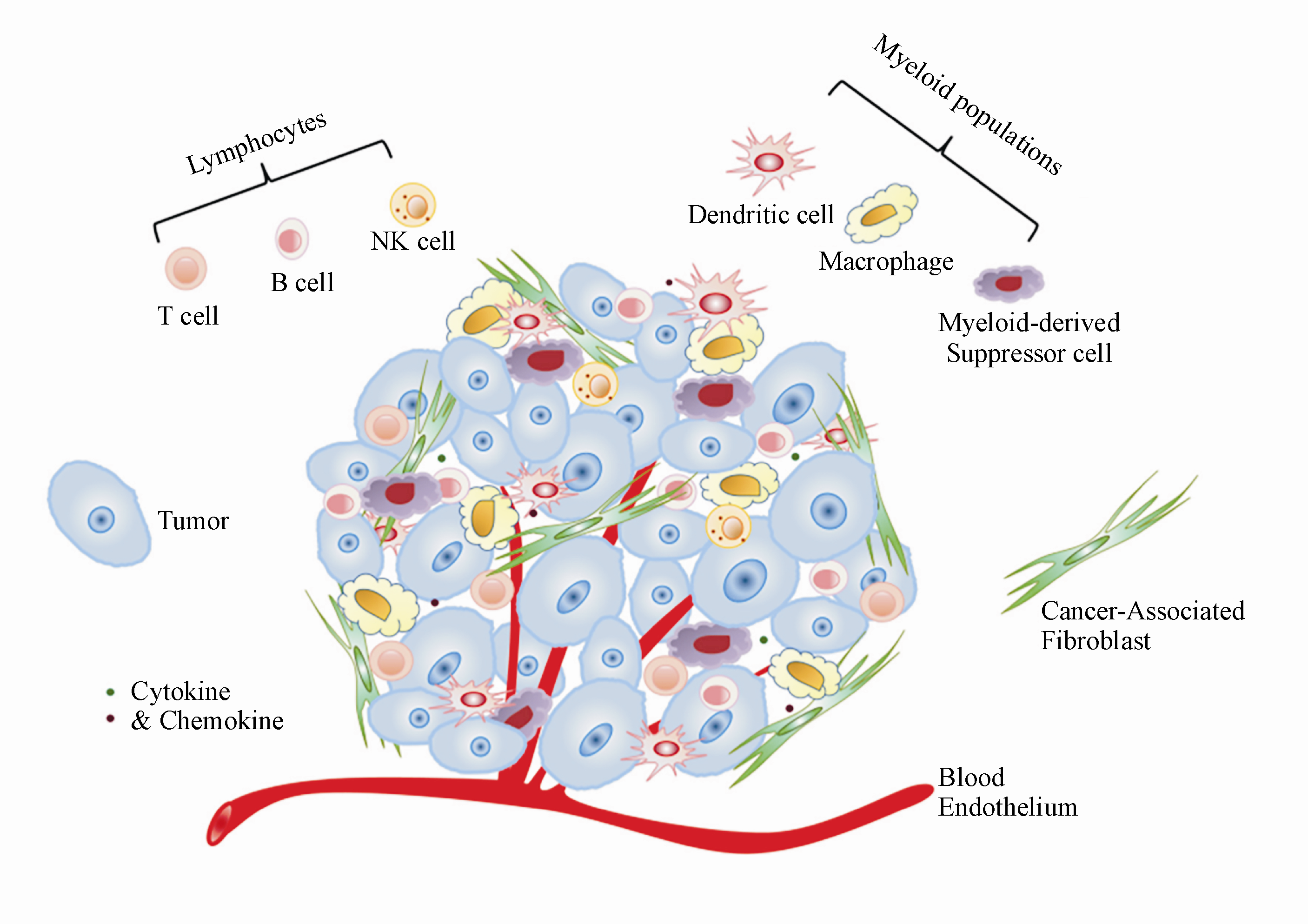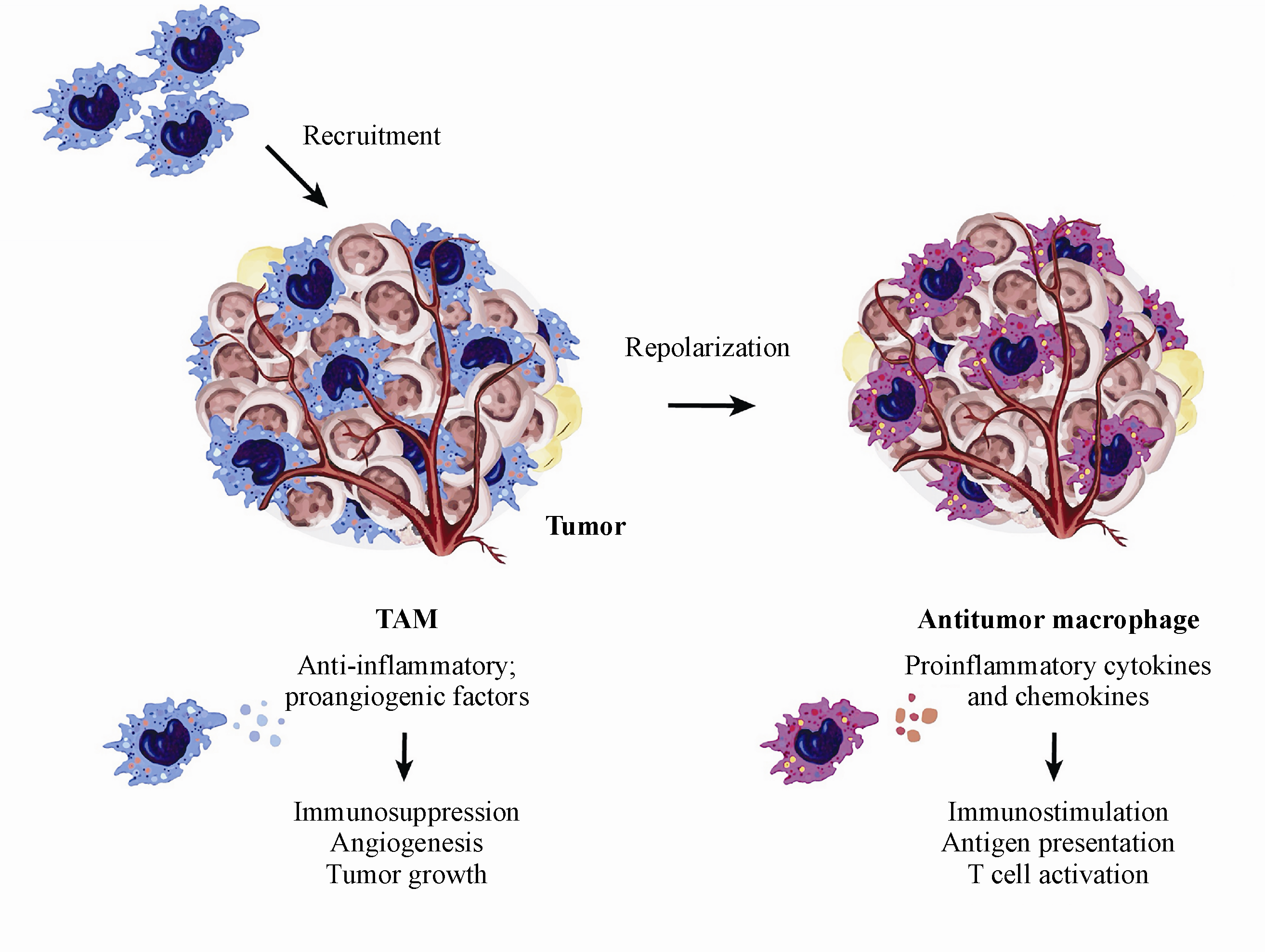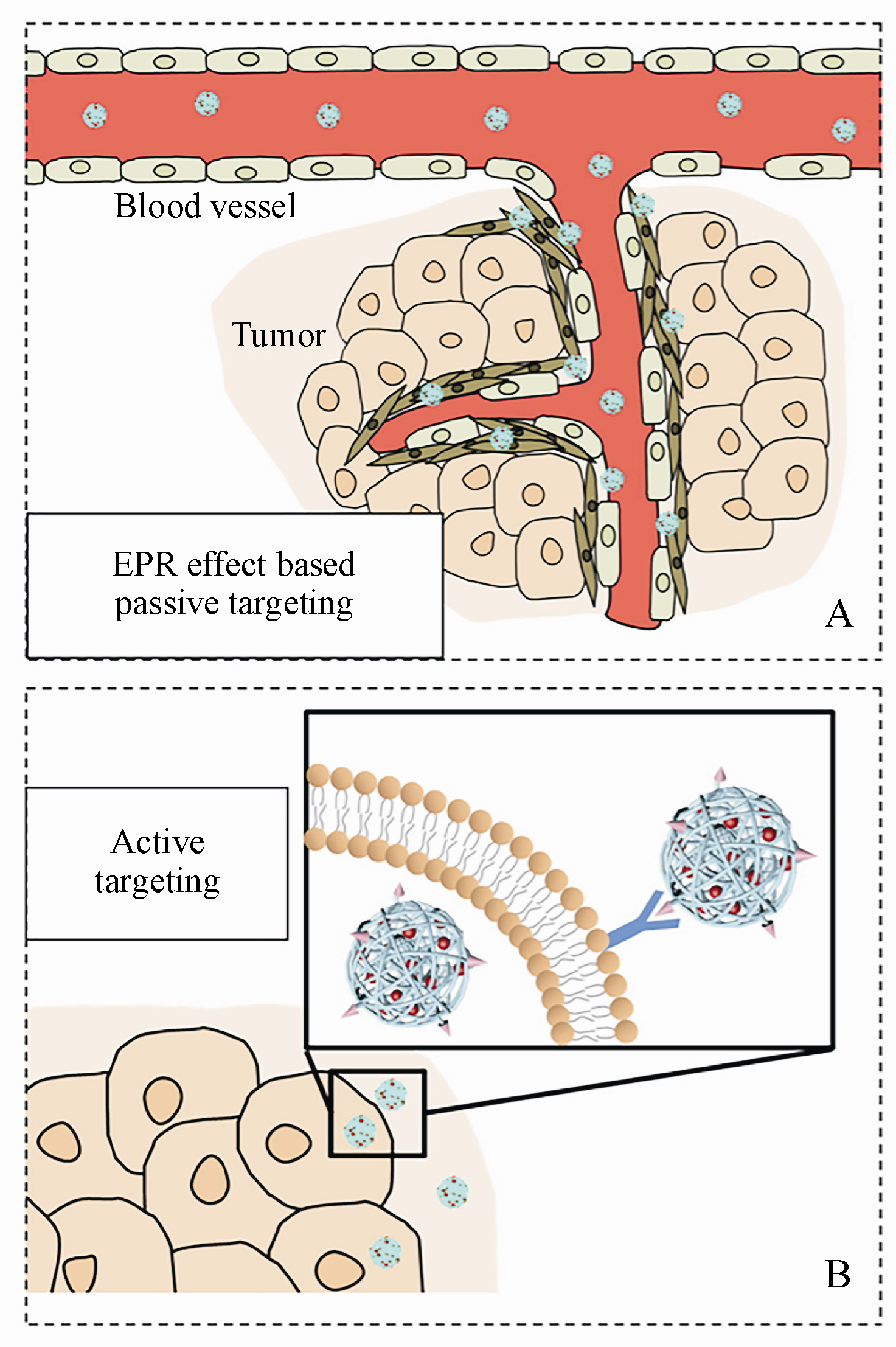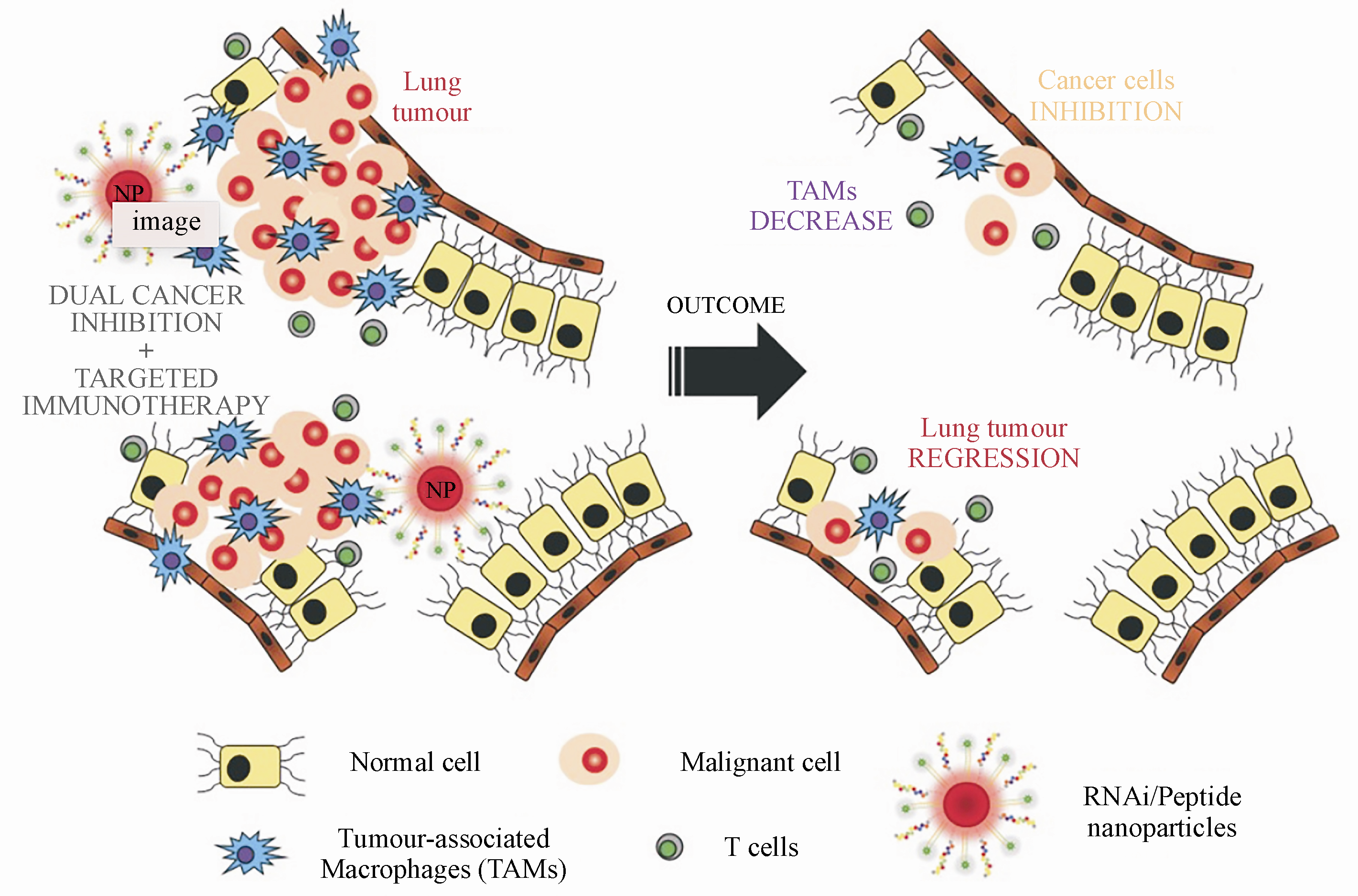摘要
肿瘤相关巨噬细胞(tumor-associated macrophages, TAMs)是肿瘤中最丰富的固有免疫细胞,TAMs常表现出抗炎性M2表型,是肿瘤发展、转移和耐药性的关键诱导因素,已经成为肿瘤免疫治疗领域的热门靶标。纳米载体的研究与应用优化了以TAMs为靶点的肿瘤治疗策略,本文根据TAMs的特性与功能,详细阐述了基于TAMs的调控策略,包括TAMs耗竭、抑制TAMs募集和TAMs复极化;同时,为了更高效地应用上述策略并克服治疗中常见的脱靶问题,分析了基于纳米载体的TAMs特异性靶向治疗策略,包括被动靶向至TAMs、巨噬细胞主动靶向策略以及M2-TAMs特异性主动靶向策略;最后,针对单独靶向TAMs疗法的局限性,介绍了纳米递送系统同时靶向TAMs和肿瘤细胞的新型治疗策略,为该策略在肿瘤免疫治疗以及与其他疗法联合治疗中的应用提供新思路。
肿瘤的发展是一个复杂的多步骤过程,包括转化、增殖、血管生成、免疫调节和转

Figure 1 Cellular constituents of the tumor microenvironmen
肿瘤相关巨噬细胞(tumor-associated macrophages,TAMs)是TME中最丰富的固有免疫细胞种群,占肿瘤质量的50
肿瘤微环境以缺氧、弱酸性为主要特征,通常不存在诱导M1型巨噬细胞极化的细菌刺激物、Th1细胞因子及代谢环境,且普遍存在Th2细胞因子,因此TAMs在肿瘤部位多呈现M2表
基于TAMs在肿瘤发生发展中的功能,TAMs靶向调控策略包括:TAMs耗竭、抑制TAMs募集和TAMs复极
TAMs调控的策略之一是使用消耗巨噬细胞的化学试剂直接清除TAMs,降低TAMs在肿瘤组织的密度,从而逆转免疫抑制型肿瘤微环
集落刺激因子1(colony-stimulating factor 1,CSF1)是大多数巨噬细胞种群的主要调节剂和趋化因子,其受体CSF1R是一种酪氨酸激酶,可促进单核细胞和巨噬细胞的存活、增殖和分
另一种TAMs消耗策略是基于双膦酸盐(bisphosphonates)的应用。鉴于对羟基磷灰石的高结合亲和力,双膦酸盐一般被用于抑制破骨细胞的功能,抑制骨吸收,从而治疗骨质疏松症、骨转移和骨科Paget's
单核细胞/巨噬细胞从血液中募集并渗入肿瘤。因此,通过靶向和影响单核细胞来破坏TAMs的产生,可有效抑制TAMs募集,减少实体瘤中的TAMs浸润,重塑免疫抑制TM
单核细胞和单核细胞型骨髓来源的抑制性细胞(monocyte-related myeloid-derived suppressor cells,M-MDSCs)是TAMs的前体,在多种化学引诱剂的指导下募集到肿瘤部位。常见的诱导剂包括趋化因子(如CCL2,CCL5)和细胞因子(如VEGF家族成员
尽管TAMs主要表现为促肿瘤表型,但巨噬细胞作为重要的吞噬细胞,同时具有抗原提呈能力。在肿瘤发展的不同阶段以及治疗过程中,TAMs具有从肿瘤促进型转换为肿瘤杀伤型的能力,并通过激活免疫反应抑制肿瘤的生

Figure 2 Illustration of TAMs repolarizatio
一种手段是通过阻断CD47/SIRPα(“别吃我”)信号,增强TAMs的吞噬特性,恢复对肿瘤细胞的清除机
Toll样受体(TLR)是一种模式识别受体(pattern recognition receptor,PRR),在先天免疫应答的激活中具有重要作用。细菌颗粒(如LPS)或病毒核酸(RNA或DNA)对TLR的激活能够诱导免疫反应,使巨噬细胞趋向于促炎的M1表型。不同的TLR激动剂可模拟微生物信号,将TAMs转换为杀伤肿瘤的表
此外,与巨噬细胞表型极化相关的信号通路中的关键激酶也可作为调节的靶点,几种小分子抑制剂通过调节巨噬细胞的重新极化发挥抗肿瘤作用。例如,PI-3激酶γ(PI-3 kinase gamma,PI3Kγ)是介导TAMs免疫抑制作用的关键调节剂,其抑制剂通过诱导M1-TAMs产生炎症反应,阻止肿瘤生
另一个有潜力的策略是在表观遗传水平上诱导TAMs复极化。如组蛋白去乙酰化酶(histone deacetylase,HDAC)抑制剂TMP195能够改变TAMs表观遗传学特征,从而使其趋向于M1行为,诱导它们在乳腺癌TME中积累,并增强其吞噬活
除此之外,一些无机纳米粒如氧化铁纳米粒、碳酸钙纳米粒等,可通过调节活性氧、肿瘤微环境的酸度等介导TAM的复极
相比于TAMs耗竭和抑制TAMs募集策略,TAMs复极化策略不仅使免疫抑制型TAMs减少,还使促炎表型巨噬细胞增加,更高效地逆转了免疫抑制型TME。同时,该策略避免了巨噬细胞急剧减少对正常组织的影响,不良反应较小。因此,TAMs复极化策略在肿瘤免疫治疗领域受到更广泛的关注。
许多针对不同分子靶标的药物具有调节TAMs进而对抗肿瘤的潜力。下一个挑战是如何将这些免疫调节药物有效地、选择性地传递给TAMs,最大限度地降低脱靶问题和药物不良反应。着眼于纳米递药技术的最新进展,纳米材料介导的TAMs靶向策略,可特异性增强抗肿瘤免疫反应,已展现出明显的临床前疗效和潜在的临床意义。目前,靶向TAMs纳米载体的设计主要依赖于肿瘤血管的高通透性和高滞留(enhanced permeability and retention,EPR)效应以及受体与配体或抗原与抗体间的相互识别作用,分别称为“被动靶向”和“主动靶向”策

Figure 3 Current targeting strategies for cancer therapy
A:Passive targeting based on EPR effect;B:Active targeting based on ligand-receptor or antibody-antigen interactio
作为生物体内清除细胞碎片、病原体和异物的主要细胞,巨噬细胞具有很高的吞噬能力。对于纳米载药系统,巨噬细胞可以不加选择地使其内在化,且通常M2-TAMs比M1-TAMs表现出更高的纳米粒内化效率。另外,TAMs是TME中最丰富的细胞种群,靶向肿瘤部位的纳米粒通过非特异性脱靶效应,可以被TAMs摄取。如双膦酸盐脂质体依赖在肿瘤部位的被动积累,诱导动物体内TAMs的凋亡,是目前耗竭TAMs的主要纳米制
基于EPR效应和巨噬细胞自身的吞噬能力,纳米载药系统可以被动靶向至TAMs,并对其进行特异性调控,从而改善免疫抑制型肿瘤微环境,最终发挥抗肿瘤作用。然而,仍有大部分纳米粒在TME中被肿瘤细胞或其他非恶性细胞内吞,从而降低其在TAMs中的富集水平,削弱了调控效果。因此,基于TAMs高表达的表面受体,设计特异性配体修饰型的纳米载体用于主动靶向TAMs,可有效提高内吞和调控效
甘露糖受体(CD206)由于在巨噬细胞上过表达而成为最常用的TAMs靶向受体之
叶酸受体β(folate receptor β,FRβ)也是巨噬细胞高表达的表面受体,其与叶酸具有纳摩尔级别的高度亲和力。因此,可使用其配体叶酸修饰纳米粒介导TAMs靶向递
豆荚蛋白(legumain)和转铁蛋白受体(transferrin receptor)是在巨噬细胞过表达的另外两个靶标受体,且广泛存在于几种肿瘤细胞类型
基于豆荚蛋白对Ala-Ala-Asn底物序列的蛋白水解活性,可设计靶向TAMs前药或智能药物递送系
尽管TAMs高表达的转铁蛋白受体受到广泛关注,且研究者们已经报道了许多靶向转铁蛋白受体的药物递送系统。但所有这些系统都是针对靶向表达该受体的肿瘤细胞而设计的,尚未见对TAMs具体应用的报
甘露糖受体、叶酸受体β以及豆荚蛋白除了在M2-TAMs表面高表达之外,在TME中其他细胞(如树突状细胞、M1-TAMs和肿瘤细胞等)也有表
在临床上,针对肿瘤细胞本身的治疗仍然是肿瘤药物治疗领域的主要手段。然而,单独靶向恶性细胞的疗法不仅效果不理想,还常常引起肿瘤对单一药物的耐药性。因此,针对肿瘤细胞和微环境中的主导免疫细胞(TAMs)的联合治疗策略备受关注。该策略具有以下优
Chen

Figure 4 Schematic of the combined silencing therapy in vivo via nanoparticles targeting TAMs and cancer cell
TAMs是TME中最丰富的免疫细胞种群,由于与肿瘤生长、转移扩散和治疗失败密切相关,成为肿瘤免疫治疗的热门靶标。抑制TAMs募集、耗竭TAMs和使TAMs复极化3种策略均具有调控TAMs从而逆转免疫抑制性TME的可行性。同时,主/被动靶向型纳米载体的应用,进一步优化了TAMs靶向调控策略。然而,据报道,纳米粒到达肿瘤部位后,常常脱靶至TME中丰富的肿瘤细胞,使单独靶向TAMs的疗法不能达到理想的抗肿瘤效
此外,TME中还存在多种其他免疫细胞,它们对于肿瘤增殖和转移同样起到关键作用。在未来的研究中,将M2-TAMs与其他免疫细胞(如T细胞、NK细胞等)的调控药物共载于纳米递送系统中,有望更高效地改善TME;与此同时,对纳米载体进行更多功能化修饰,改善药物的循环稳定性和生物分布,并实现可控的药物释放,将成为TME靶向调控策略的下一个研究方向。
References
Cai H,Liu YH,Yin TJ,et al. Advances in the targeted therapy of tumor-associated fibroblasts[J]. J China Pharm Univ(中国药科大学学报),2018,49(1):20-25. [百度学术]
Bian XJ,Xiao YT,Wu TQ,et al. Microvesicles and chemokines in tumor microenvironment:mediators of intercellular communications in tumor progression[J]. Mol Cancer,2019,18(1):50. [百度学术]
Brassart-Pasco S,Brézillon S,Brassart B,et al. Tumor microenvironment:extracellular matrix alterations influence tumor progression[J]. Front Oncol,2020,10:397. [百度学术]
Novikova MV,Khromova NV,Kopnin PB. Components of the hepatocellular carcinoma microenvironment and their role in tumor progression[J]. Biochemistry (Mosc),2017,82(8):861-873. [百度学术]
Dehne N,Mora J,Namgaladze D,et al. Cancer cell and macrophage cross-talk in the tumor microenvironment[J]. Curr Opin Pharmacol,2017,35:12-19. [百度学术]
Bi L,Gao J,Jiang YC,et al. Effect of Ginseng,Ginseng polysaccharides and Ginsenoside on the human lung cancer cells A549 in co-culture system of TAMs with A549 cells[J]. J China Pharm Univ(中国药科大学学报),2016,47(6):744-748. [百度学术]
Yang L,Zhang Y. Tumor-associated macrophages:from basic research to clinical application[J]. J Hematol Oncol,2017,10(1):58. [百度学术]
Jeannin P,Paolini L,Adam C,et al. The roles of CSFs on the functional polarization of tumor-associated macrophages[J]. FEBS J,2018,285(4):680-699. [百度学术]
Jayasingam SD,Citartan M,Thang TH,et al. Evaluating the polarization of tumor-associated macrophages into M1 and M2 phenotypes in human cancer tissue:technicalities and challenges in routine clinical practice[J]. Front Oncol,2019,9:1512. [百度学术]
Binnemars-Postma K,Storm G,Prakash J. Nanomedicine strategies to target tumor-associated macrophages[J]. Int J Mol Sci,2017,18(5):E979. [百度学术]
Petty AJ,Yang YP. Tumor-associated macrophages:implications in cancer immunotherapy[J]. Immunotherapy,2017,9(3):289-302. [百度学术]
Chen XJ,Wu S,Yan RM,et al. The role of the hypoxia-Nrp-1 axis in the activation of M2-like tumor-associated macrophages in the tumor microenvironment of cervical cancer[J]. Mol Carcinog,2019,58(3):388-397. [百度学术]
Lin YX,Xu JX,Lan HY. Tumor-associated macrophages in tumor metastasis:biological roles and clinical therapeutic applications[J]. J Hematol Oncol,2019,12(1):76. [百度学术]
Chen YB,Song YC,Du W,et al. Tumor-associated macrophages:an accomplice in solid tumor progression[J]. J Biomed Sci,2019,26(1):78. [百度学术]
Laviron M,Boissonnas A. Ontogeny of tumor-associated macrophages[J]. Front Immunol,2019,10:1799. [百度学术]
Malfitano AM,Pisanti S,Napolitano F,et al. Tumor-associated macrophage status in cancer treatment[J]. Cancers,2020,12(7):1987. [百度学术]
Cui Y,Guo G. Immunomodulatory function of the tumor suppressor p53 in host immune response and the tumor microenvironment[J]. Int J Mol Sci,2016,17(11):1942. [百度学术]
Cassetta L,Pollard JW. Targeting macrophages:therapeutic approaches in cancer[J]. Nat Rev Drug Discov,2018,17(12):887-904. [百度学术]
Li X,Liu R,Su X,et al. Harnessing tumor-associated macrophages as aids for cancer immunotherapy[J]. Mol Cancer,2019,18(1):177. [百度学术]
O'Brien SA,Orf J,Skrzypczynska KM,et al. Activity of tumor-associated macrophage depletion by CSF1R blockade is highly dependent on the tumor model and timing of treatment[J]. Cancer Immunol Immunother,2021. doi:10.1007/s00262-021-02861-3. [百度学术]
Cannarile MA,Weisser M,Jacob W,et al. Colony-stimulating factor 1 receptor (CSF1R) inhibitors in cancer therapy[J]. J Immunother Cancer,2017,5(1):53. [百度学术]
Ries CH,Cannarile MA,Hoves S,et al. Targeting tumor-associated macrophages with anti-CSF-1R antibody reveals a strategy for cancer therapy[J]. Cancer Cell,2014,25(6):846-859. [百度学术]
Billington EO,Reid IR. Benefits of bisphosphonate therapy:beyond the skeleton[J]. Curr Osteoporos Rep,2020,18(5):587-596. [百度学术]
Andón FT,Digifico E,Maeda A,et al. Targeting tumor associated macrophages:The new challenge for nanomedicine[J]. Semin Immunol,2017,34:103-113. [百度学术]
Phuengkham H,Ren L,Shin IW,et al. Nanoengineered immune niches for reprogramming the immunosuppressive tumor microenvironment and enhancing cancer immunotherapy[J]. Adv Mater,2019,31(34):e1803322. [百度学术]
Singh Y,Pawar VK,Meher JG,et al. Targeting tumor associated macrophages (TAMs) via nanocarriers[J]. J Control Release,2017,254:92-106. [百度学术]
Ngambenjawong C,Gustafson HH,Pun SH. Progress in tumor-associated macrophage (TAM)-targeted therapeutics[J]. Adv Drug Deliv Rev,2017,114:206-221. [百度学术]
Zang X,Zhang X,Hu H,et al. Targeted delivery of zoledronate to tumor-associated macrophages for cancer immunotherapy[J]. Mol Pharm,2019,16(5):2249-2258. [百度学术]
Goswami KK,Ghosh T,Ghosh S,et al. Tumor promoting role of anti-tumor macrophages in tumor microenvironment[J]. Cell Immunol,2017,316:1-10. [百度学术]
Argyle D,Kitamura T. Targeting macrophage-recruiting chemokines as a novel therapeutic strategy to prevent the progression of solid tumors[J]. Front Immunol,2018,9:2629. [百度学术]
Nywening TM,Wang-Gillam A,Sanford DE,et al. Targeting tumour-associated macrophages with CCR2 inhibition in combination with FOLFIRINOX in patients with borderline resectable and locally advanced pancreatic cancer:a single-centre,open-label,dose-finding,non-randomised,phase 1b trial[J]. Lancet Oncol,2016,17(5):651-662. [百度学术]
Shapouri-Moghaddam A,Mohammadian S,Vazini H,et al. Macrophage plasticity,polarization,and function in health and disease[J]. J Cell Physiol,2018,233(9):6425-6440. [百度学术]
Ruytinx P,Proost P,van Damme J,et al. Chemokine-induced macrophage polarization in inflammatory conditions[J]. Front Immunol,2018,9:1930. [百度学术]
Pathria P,Louis TL,Varner JA. Targeting tumor-associated macrophages in cancer[J]. Trends Immunol,2019,40(4):310-327. [百度学术]
Veillette A,Chen J. SIRPα-CD47 immune checkpoint blockade in anticancer therapy[J]. Trends Immunol,2018,39(3):173-184. [百度学术]
Weiskopf K,Jahchan NS,Schnorr PJ,et al. CD47-blocking immunotherapies stimulate macrophage-mediated destruction of small-cell lung cancer[J]. J Clin Invest,2016,126(7):2610-2620. [百度学术]
Feng Y,Mu R,Wang Z,et al. A toll-like receptor agonist mimicking microbial signal to generate tumor-suppressive macrophages[J]. Nat Commun,2019,10(1):2272. [百度学术]
Rodríguez-Ruiz ME,Perez-Gracia JL,Rodríguez I,et al. Combined immunotherapy encompassing intratumoral poly-ICLC,dendritic-cell vaccination and radiotherapy in advanced cancer patients[J]. Ann Oncol,2018,29(5):1312-1319. [百度学术]
Georgoudaki AM,Prokopec KE,Boura VF,et al. Reprogramming tumor-associated macrophages by antibody targeting inhibits cancer progression and metastasis[J]. Cell Rep,2016,15(9):2000-2011. [百度学术]
Locatelli SL,Careddu G,Serio S,et al. Targeting cancer cells and tumor microenvironment in preclinical and clinical models of Hodgkin lymphoma using the dual PI3Kδ/γ inhibitor RP6530[J]. Clin Cancer Res,2019,25(3):1098-1112. [百度学术]
Guerriero JL,Sotayo A,Ponichtera HE,et al. Class IIa HDAC inhibition reduces breast tumours and metastases through anti-tumour macrophages[J]. Nature,2017,543(7645):428-432. [百度学术]
Chen Q,Wang C,Zhang X,et al. In situ sprayed bioresponsive immunotherapeutic gel for post-surgical cancer treatment[J]. Nat Nanotechnol,2019,14(1):89-97. [百度学术]
Song K,Pan H,Han JY,et al. Nano drug delivery system based strategies to target tumor microenvironment[J]. J China Pharm Univ(中国药科大学学报),2018,49(4):392-400. [百度学术]
Dai W,Wang X,Song G,et al. Combination antitumor therapy with targeted dual-nanomedicines[J]. Adv Drug Deliv Rev,2017,115:23-45. [百度学术]
La-Beck NM,Liu XL,Shmeeda H,et al. Repurposing amino-bisphosphonates by liposome formulation for a new role in cancer treatment[J]. Semin Cancer Biol,2021,68:175-185. [百度学术]
Wakaska RR. Challenges pertaining to adverse effects of drugs[J]. Int J Drug Dev Res,2017,9(1):1-2. [百度学术]
An YY,Yang Q. Tumor-associated macrophage-targeted therapeutics in ovarian cancer[J]. Int J Cancer,2020. doi:10.1002/ijc.33408. [百度学术]
Zang XL,Zhang XX,Zhao XL,et al. Targeted delivery of miRNA 155 to tumor associated macrophages for tumor immunotherapy[J]. Mol Pharm,2019,16(4):1714-1722. [百度学术]
Sun X,Gao D,Gao L,et al. Molecular imaging of tumor-infiltrating macrophages in a preclinical mouse model of breast cancer[J]. Theranostics,2015,5(6):597-608. [百度学术]
Tie Y,Zheng H,He ZY,et al. Targeting folate receptor β positive tumor-associated macrophages in lung cancer with a folate-modified liposomal complex[J]. Signal Transduct Target Ther,2020,5(1):6. [百度学术]
Hattori Y,Yamashita J,Sakaida C,et al. Evaluation of antitumor effect of zoledronic acid entrapped in folate-linked liposome for targeting to tumor-associated macrophages[J]. J Liposome Res,2015,25(2):131-140. [百度学术]
Weiskopf K,Anderson KL,Ito D,et al. Eradication of canine diffuse large B-cell lymphoma in a murine xenograft model with CD47 blockade and anti-CD20[J]. Cancer Immunol Res,2016,4(12):1072-1087. [百度学术]
Franklin RA,Liao W,Sarkar A,et al. The cellular and molecular origin of tumor-associated macrophages[J]. Science,2014,344(6186):921-925. [百度学术]
Lin Y,Wei C,Liu Y,et al. Selective ablation of tumor-associated macrophages suppresses metastasis and angiogenesis[J]. Cancer Sci,2013,104(9):1217-1225. [百度学术]
Kang T,Jiang MY,Jiang D,et al. Enhancing glioblastoma-specific penetration by functionalization of nanoparticles with an iron-mimic peptide targeting transferrin/transferrin receptor complex[J]. Mol Pharm,2015,12(8):2947-2961. [百度学术]
Qian Y,Qiao S,Dai YF,et al. Molecular-targeted immunotherapeutic strategy for melanoma via dual-targeting nanoparticles delivering small interfering RNA to tumor-associated macrophages[J]. ACS Nano,2017,11(9):9536-9549. [百度学术]
Peng H,Wang JH,Guo F,et al. Legumain protease-activated tuftsin-functionalized nanoparticles for dual-targeting TAMs and cancer chemotherapy[J]. Colloids Surf B Biointerfaces,2021,197:111442. [百度学术]
Cieslewicz M,Tang JJ,Yu JL,et al. Targeted delivery of proapoptotic peptides to tumor-associated macrophages improves survival[J]. Proc Natl Acad Sci U S A,2013,110(40):15919-15924. [百度学术]
Pang L,Pei YH,Uzunalli G,et al. Surface modification of polymeric nanoparticles with M2pep peptide for drug delivery to tumor-associated macrophages[J]. Pharm Res,2019,36(4):65. [百度学术]
Brahmer JR,Tykodi SS,Chow LQ,et al. Safety and activity of anti-PD-L1 antibody in patients with advanced cancer[J]. N Engl J Med,2012,366(26):2455-2465. [百度学术]
Wu XL,Wu YD,Ye HB,et al. Interleukin-15 and cisplatin co-encapsulated thermosensitive polypeptide hydrogels for combined immuno-chemotherapy[J]. J Control Release,2017,255:81-93. [百度学术]
Chen J,Dou Y,Tang Y,et al. Folate receptor-targeted RNAi nanoparticles for silencing STAT3 in tumor-associated macrophages and tumor cells[J]. Nanomedicine,2020,25:102173. [百度学术]
Conde J,Bao CC,Tan YQ,et al. Dual targeted immunotherapy via in vivo delivery of biohybrid RNAi-peptide nanoparticles to tumour-associated macrophages and cancer cells[J]. Adv Funct Mater,2015,25(27):4183-4194. [百度学术]
Sylvestre M,Crane CA,Pun SH. Progress on modulating tumor-associated macrophages with biomaterials[J]. Adv Mater,2020,32(13):e1902007. [百度学术]
Yang QY,Guo NN,Zhou Y,et al. The role of tumor-associated macrophages (TAMs) in tumor progression and relevant advance in targeted therapy[J]. Acta Pharm Sin B,2020,10(11):2156-2170. [百度学术]